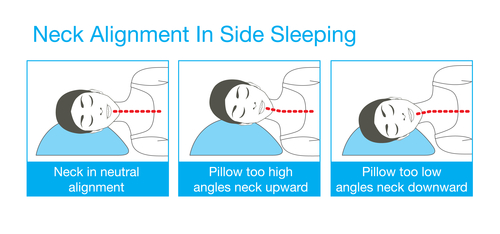Neck Pain From Sleeping – Your Pillow is a Key Factor!
by Julie Donnelly, The Pain Relief Expert
“What causes neck pain from sleeping?” is a question I’m asked over and over. I think it’s important to go into this question in depth. If you have neck pain, or you suffer from ringing in your ears, dizziness, or ear pain, there is a good possibility that it may be caused by the way you are sleeping. Your pillow could be the culprit!
To Prevent Neck Pain From Sleeping, Your Head, Neck, and Spine Must Be In Alignment

The thickness of your pillow is a key to preventing neck pain from sleeping.
If you sleep on your side, and your pillow is too thick, your head is tilted up toward the ceiling for hours. If your pillow is too thin, your head is tilted down toward the mattress for hours. You will have neck pain from sleeping, and you may never consider your pillow as your problem.

Take a look at this picture and it will be clear. He is lying on his left side and his pillow is too thick, so his head is leaning up toward the ceiling. The muscles on the man’s right side are shortened in order for his head to tilt in that direction. As you can see the left side of his neck has lengthened. As he holds this position for hours the muscles on the right side of his neck will keep getting tighter.
Then he turns over in his sleep, the shortened right side muscles are now being stretched. However, the spasms are preventing the right muscle from lengthening and his cervical vertebrae are being pulled out of alignment. The misalignment is putting pressure on his spinal cord and all of the nerves in his neck.
This is what is happening to you if your pillow is too thin or too thick. If you also slightly turn your head to one side or the other you are contracting another important muscle – the sternocleidomastoid (SCM for short).
Your SCM originates on your collarbone and inserts into the bone behind your ear. When your SCM contracts you turn your head to the opposite side. If you have your head even slightly turned as you sleep, your SCM shortens. When you bring your head back so you are facing forward, the tight muscle will pull on the bone behind your ear and cause havoc. As the tight SCM is pulling, it causes a strain on the tiny bones inside your ear.
Sleeping with your head turned may cause:
- pain,
- tinnitus,
- dizziness,
- loss of equilibrium,
- headaches,
- pain in your eye and around your skull,
- pain at the top of your head,
- and even pain in your throat.
Amazing! Although it’s rare that this muscle is considered when a medical professional is searching for the cause of your symptoms.
If you sleep on your stomach with your head turned, these symptoms may be even greater.
Neck Pain and Headaches Caused by a Forward Tilted Head

If you fall asleep on the sofa, with your head tilted forward, you are straining your neck. The neck strain causes muscles in the front of your neck to shorten, and the back of your neck to overstretched.
This position puts a strain on your cervical disks. As your cervical vertebrae are forced out of alignment they can cause pressure on your spinal cord.
Sleeping in your bed with your head propped up on a pillow will do the same thing

If you sleep on your back, your head should be on the mattress (not propped up with a pillow) because it will keep your spine straight. Or you could have a tiny support (like a folded washcloth) under your neck to support your cervical vertebrae. You can have a wedge pillow that starts at your mid-back and gently raises your entire trunk and head up while still allowing your head and back to be in a straight line.
Sleeping on your stomach is so problematic that it behooves you to force yourself to change your position. Let me know and I’ll give you some suggestions that work to change your habit of sleeping. And watch this blog as I’ll be writing about stomach sleeping in the near future. It takes time and energy, but the results are worth the effort.
It’s worthwhile to look at how you’re sleeping and adjust it so your head, neck, and spine are in a straight line.
It’s also important to know that you can easily release the tension in all of your neck muscles. Even if you do sleep wrong one night, you can stop the pain before it gets out of hand. If you want to learn how to do easy self-applied treatments to eliminate tinnitus and neck pain I suggest you get Treat Yourself to Pain-Free Living.
Wishing you well,


Joanna
Hiya, I always seem to end up sleeping on my stomach with my neck twisted uncomfortably to one side and, as it happens, I suffer from tinnitus in my left ear which is usually the side my head ends up facing too. Throughout the day my tinnitus disappears but it comes back during the night or when I am tired. I also work at a computer all day 🙁 Any tips to help me?

Julie Donnelly
Hi Joanna. The problem is your sternocleidomastoid (SCM) muscle is in spasm and has shortened due to muscle memory. While the #1 thing to do is to stop sleeping on your stomach, I know this will take some time and effort and you need a faster solution. Do you already have my book, Treat Yourself to Pain-Free Living? The treatment for the SCM is in that book. The good part about that book is it has treatments for other muscles that are being held in the contracted state while you are sleeping. The odds are you are also straining the muscles that go all the way down your back, and since your arms are probably lifted up over your head, your shoulders are also being strained.
I believe I wrote a blog a long time ago about stomach sleeping and some hints on how to soften the strain. Keep an eye on the blog and I’ll search for it, update it, and re-post it. If I can’t find it, I’ll write it again.

peanutflower
OMG. a Eureka moment. The stabbing pain in the top of my head and above one eye drove me to spend several hours today searching for something. I have tinnitus that gets worse when I lay down, recurrent stabbing sharp pain in back of head, top of head on one side and on the same side above eye, sore throat, intermittent “fuzziness in my brain” is the only way I can describe it –a feeling like there is pressure on my ears like in an airplane or something. the more stressed I get the worse all of this is as I guess my shoulders inch upwards. I have dealt with tinnitus for several years and just accepted it — of course, the doctor’s reaction is “it’s very hard to diagnose” and then no attempt was made to diagnose it. I have poor posture and head forward position after decades of computer use, but I went to physio and am working very hard at correcting that. When I work out in the gym I get this horrible pain at back base of head — always on same side — and top of head and at top of eye depending on what exercise I do. I think it’s anything where I involuntarily raise my shoulders, this maybe exacerbating this sterno whatsit thing. like disablingly sharp stabbing pain. so I guess I will figure out how my sleeping is making this worse – I htought the sore throat was due to reflux, which I don’t think I have, so I have a longish wedge pillow. I wonder if that is making it worse. I will be heading to physio with this new information. HOPefully this is the source of all of my problems. Honestly, I thought I had some kind of a sinus problem or something. Hopefully this sterno thingy is the problem.

Julie Donnelly
Hi. Every one of the symptoms you are describing are common for spasms in your sternocleidomastoid muscle (SCM for short – your physiotherapist will know that term).
There is so much I’d like to share with you about the pillow you use at night. Basically, if you sleep on your side, your head, neck, and spine need to be in a straight horizontal line. If your head is tilted either up (pillow is too thick) or down (pillow is to thin), or if you turn your head even slightly (looking up or looking down), this will cause the muscles of your neck to stay in the contracted position for hours. The sternocleidomastoid is contracted the entire time you are sleeping, causing muscle memory to shorten the fibers so when you try to turn in the opposite direction the tight muscle will pull on your bones (either your cervical vertebrae, or in the case of the SCM, the mastoid bone). If you do a search of the blogs I’ve written: http://www.blog.julstro.com, you’ll find threads where I have gone into a lot of detail about pillows.
Did you go to http://http://www.julstro.com/neck-pain/? It will explain so much more. BTW, the SCM is well-known for causing tinnitus, but most professionals don’t know how to treat the muscle effectively. The interesting thing is you can treat it yourself in very little time. It’s definitely worthwhile learning as it will need to be done several times a day until the muscle memory reverses and the muscle stays at it’s normal length. I suggest you, or your physiotherapist, also look at the levator scapulae muscle as it is responsible for pulling C1-4 out of alignment.
Wishing you well,
Julie

peanutflower
Thank you so much for your reply! I will read more on your site. What relationship can you posit between a sterno-thing and bending down causing a sharp stabbing head pain? That’s when I first noticed it. then it began to occur during workouts — I associated it with a gravity — i.e head lower than something else — issue, but then it went away, and then returned. and went away. and came back… I connect increased tinnitus, head pain, head fuzziness (my cotton wool problem I call it) with increased stress, which I guess means shoulders go up and everything cervical tightens up. I’m not young – turning 55 in two days, but I am in good physical shape, not overweight (any more). I work in front of a computer for many hours a day but have my station set up ergonomically correct, I believe — i.e monitors at the right height, chair not having a tilting seat. I am working very hard to keep good posture, and at my age after a lifetime of poor posture it’s not easy. I hurt my lower back doing a burpee over a year ago — hypextended it trying to show off. I thought perhaps the head pain was as a result of that and underwent IMS but that did nothing. Physiotherapist said my posture and head-forwardness was going to be a big problem if I didn’t take steps to fix it, and so I have been working hard. blah blah blah lol. Anyway, it would be super good if this head problem and tinnitus was connected and I could fix it. going to read more of your blogs now… I am in Victoria, BC, Canada. In case you were interested. It’s current 92 degrees here. we are not used to that…

Nemeth
Hi Donna,
I am a bit of the odd one out. I have constant tinnitus but I dont have any pain. I just discovered that my SCM muscel on my left side is much bigger then on the right side, exactly on the side I have the tinnitus and sometimes I feel a pressure right behind my ear. I also have a leg shorter then the other, casing tilted head according to my Osteo. Could this really be the SCM muscle.
Amazing, you just gave answer why I am tossing and turning during the night. I also sleep on my stomach 🙁 and turning one side to another constantly.
Could this really be the SCM ? I have tinnitus for 4 years and could be just a single muscle causing it? Since my tinntius is 24/7 – could it disappear if I treat this muscle?
You mentioned a book of yours for ear- ringing and SCM muscle ? also, can you refer to that article how to change the habit of sleeping?
Thank you very much.
Bernadett

Julie Donnelly
Hi Bernadett,
Yes, it could definitely be your SCM causing this problem. Also, unless your both legs have had an x-ray, and the bones measured to confirm that the bones are actually different lengths, the odds are very high that all that is wrong is your iliacus muscle is in spasm and is pulling your leg up toward your pelvis. That is also easy to treat.
I suggest you get Treat Yourself to Pain-Free Living as both of these treatments are taught in that book. The treatment for your SCM is in the Neck/Shoulder chapter, and the treatment for your iliacus is in the Upper Leg and Hip chapters. For your leg, do the treatment for your thigh (specifically the rectus femoris) which is in the Upper Leg chapter, and the do all of the treatments taught in the Hip chapter as they are all involved in this problem.
Please let me know how you are doing after you finish the treatments.
Wishing you well,
Julie

Julie Donnelly
Hi Again….I forgot to mention how to change your sleeping position. Get a firm body-length pillow for both sides of your body, lie on your side and then snuggle the pillows up to you so you are forced to either not turn over on your stomach. Also, be sure that your pillow is the right thickness so your head/neck/spine are all in a horizontal line with the mattress. You want to make sure your head is not tilted down toward the bed, or up toward the ceiling.
Wishing you well,
Julie